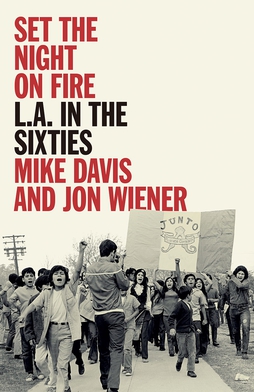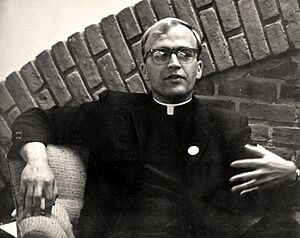Set the Night on Fire facts for kids

Book Jacket
|
|
| Author | Mike Davis, Jon Wiener |
|---|---|
| Audio read by | Ron Butler |
| Country | United States |
| Language | English |
| Genre | History |
| Publisher | Verso Books (print), Audible Studios (audiobook) |
|
Publication date
|
2020 (Hardcover, Kindle, and Audiobook) |
| Media type | Print, Kindle, Audiobook |
| Pages | 800pp., 25 hours and 25 minutes audio. |
| ISBN | 978-1784780227 |

Set the Night on Fire: L.A. in the Sixties is a book by Mike Davis and Jon Wiener. It tells the story of Los Angeles during the 1960s. The authors used old records and talked to people who lived through that time. They also shared their own experiences from movements that fought for fairness and peace.
The book is not a full history of Los Angeles in the 1960s. Instead, it aims to correct common ideas about that time. It focuses on the stories of everyday people and groups who worked to change the city. These groups helped shift power away from a small, powerful elite. They opened doors for more equal opportunities for everyone.
Mike Davis, born in 1946, is an American writer and historian. He is known for studying power and social groups in Southern California. Jon Wiener, born in 1944, is an American historian and journalist. He lives in Los Angeles.
Contents
Exploring Los Angeles in the 1960s
This book covers more than ten years. It starts by describing Los Angeles in the 1950s. It ends with Tom Bradley, an African American city councilman, defeating Mayor Sam Yorty.
Life in Los Angeles Before the 1960s
In the 1950s, Los Angeles was known for its relaxed surf culture. It was also known for beatniks and the lives of famous people. Images of Hollywood and Venice Beach were popular. But behind the scenes, the city had many problems. There were unfair practices and tough police actions. Police chief William H. Parker and Mayor Sam Yorty held strong control.
By the early 1960s, the city's perfect image began to crack. New movements for change started to grow. These movements would later define the decade.
Movements for Change and Fairness
Set the Night on Fire explores many important movements. These include the fight to end segregation and the start of the Black Power movement. It also covers the struggle for equal rights for all people. The book looks at how new media helped spread ideas. It shares stories of people who protested the war. It also tells about activist nuns and priests.
The book highlights the "blowouts" in 1968. These were student protests in Chicano East Los Angeles. The authors want to tell a different story of the 1960s. They believe Los Angeles history is often told by wealthy, powerful people. This creates a myth that hides the real experiences of most citizens.
The book focuses on working-class people and students. It includes black and brown communities. It also highlights those who faced unfair treatment because of their gender. These are the people whose stories make up the history in Set the Night on Fire. Their separate and sometimes connected movements form the book's main story.
The Fight for Civil Rights
The Civil Rights Movement is a main focus of the book. Chapters discuss Malcolm X and the Nation of Islam. They also look at unfairness between white and minority communities. There is a special focus on the fight against segregated housing.
The book highlights groups like the Congress of Racial Equality and the National Association for the Advancement of Colored People (NAACP). It also mentions Maulana Karenga and the US Organization, and the Student Nonviolent Coordinating Committee (SNCC). The United Civil Rights Committee also played a role.
The book covers the Watts Uprising and the Watts Renaissance. It tells the story of civil rights activist Angela Davis. It also explores the start of the Chicanx movement in East Los Angeles.
Equal Rights for All People
The book also covers the struggle for women's rights and equal rights for LGBT people. It describes police actions at the Black Cat Tavern in 1967. This event led to a rise in LGBT activism in Los Angeles. It also led to the founding of The Advocate magazine and the Metropolitan Community Church.
While equal rights for women are a theme throughout the book, one chapter focuses on "The Many Faces of Women's Liberation." The Los Angeles chapter of the National Organization for Women is important here. Topics include equal pay, fair wages, and child care. The book also discusses the special challenges faced by women of color.
Religion's role in the civil rights movement is also shown. It highlights the differences and struggles involving the Metropolitan Community Church, Sister Corita Kent, Father William DuBay, and Cardinal James Francis McIntyre.
Looking Back at the 1960s
The book ends by looking at the "unrealized hopes of the 1960s." It explores why these movements achieved some goals but not all. The authors note that sometimes, the different groups struggled to work together. For example, the African-American and Latino communities, despite their own changes, found it hard to form lasting partnerships. The authors wonder how Los Angeles history might have changed if these groups had worked more closely.
Recognition for the Book
Set the Night on Fire has received praise for its detailed look at Los Angeles in the 1960s. It shows a city full of change and protest. Many feel it connects the past struggles for civil rights to today's movements.
The book helps fill in missing parts of history. It focuses on movements from South and East Los Angeles. It highlights the fight for fair housing and equal opportunities in schools and jobs. It also brings to light forgotten heroes who risked much to expose unfairness.
The book shows how unfairness works and its long-term effects. It offers hope that activism can help overcome social and economic divisions. It encourages fighting for equal rights and justice.
Awards and recognition
- Set the Night on Fire was a Los Angeles Times Best Seller.


